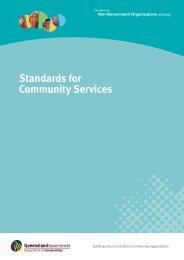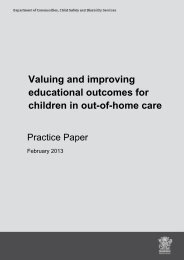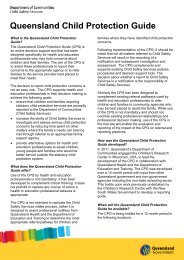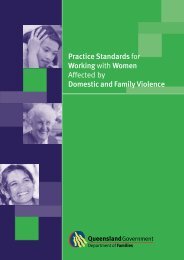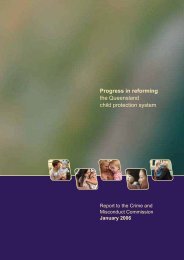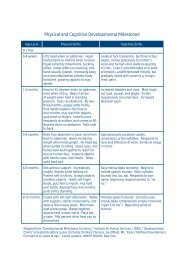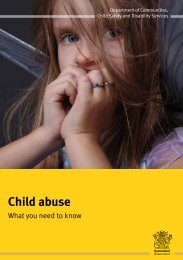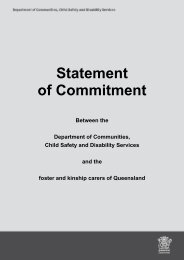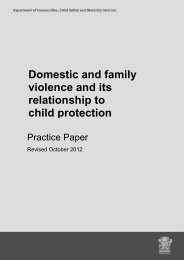Housing and Support Program (HASP): Final Evaluation Report
Housing and Support Program (HASP): Final Evaluation Report
Housing and Support Program (HASP): Final Evaluation Report
Create successful ePaper yourself
Turn your PDF publications into a flip-book with our unique Google optimized e-Paper software.
Section 1<br />
Introduction<br />
Since the 1970s, mental health policy in Australia has promoted the downsizing of<br />
‘st<strong>and</strong>-alone’ psychiatric hospitals <strong>and</strong> the decentralisation of mental health services<br />
into the broader community. The rationale for these reforms was based on the belief that<br />
community alternatives would provide a therapeutic <strong>and</strong> rehabilitation function such<br />
that individuals would move from higher to lower levels of dependence <strong>and</strong> eventually,<br />
to independence (Bachrach, 1989). Underpinning the process was the desire to provide<br />
a range of community supports that best suited the needs of people leaving hospital<br />
<strong>and</strong> also, new consumers with serious mental illness.<br />
There was an underlying belief that many of the<br />
services provided in the institution could be better<br />
provided in the community or in the individual’s own<br />
home (Bachrach, 1989). The movement towards the<br />
closure of psychiatric hospitals was driven in part by<br />
the philosophy of freedom, independence <strong>and</strong> the<br />
hope of providing a better quality of life for individuals<br />
with mental illness in the community (Meehan, 2007).<br />
Mental health policy in Queensl<strong>and</strong> has also been<br />
infl uenced by these broader trends in service reform.<br />
Over the past 20 years, a signifi cant number of<br />
individuals have been relocated to the community<br />
under hospital downsizing programs such as<br />
‘Project 300’ (Meehan et al, 2011). While many of these<br />
former long-stay clients are now elderly or deceased,<br />
a new group of individuals with severe disability has<br />
emerged. This group is made up of young, mostly male<br />
clients with a diagnosis of schizophrenia, frequently<br />
complicated by substance misuse (Meehan, 2007;<br />
Reul<strong>and</strong>, Schwarzfeld, & Draper, 2009). Many of these<br />
clients are too disabled or fearful to make <strong>and</strong> keep<br />
appointments at mental health centres <strong>and</strong> are at high<br />
risk of homelessness <strong>and</strong> frequent contact with police<br />
<strong>and</strong> other community agencies (Fry, O’Riordan, &<br />
Geanellos, 2002; Commonwealth of Australia, 2006).<br />
In Queensl<strong>and</strong>, a continuum of housing options has<br />
emerged to cater for the needs of those with more<br />
severe problems. These services range from 24-hour<br />
residential care (in the form of Community Care Units)<br />
through to independent living options. One of the<br />
initiatives in this continuum includes ‘supported’<br />
housing. Individuals are provided with public housing<br />
<strong>and</strong> are supported by visiting workers, typically<br />
employed through the non-government sector. This<br />
non-clinical support is aimed at assisting the individual<br />
to access required services in their local community,<br />
manage day-to-day living activities <strong>and</strong> sustain their<br />
tenancies (O’Malley & Croucher, 2005).<br />
One of the earliest supported housing models to be<br />
introduced in Queensl<strong>and</strong> was known as ‘Project 300’.<br />
The program was established in 1995 with the aim<br />
of relocating 300 individuals with severe psychiatric<br />
disability from the three existing psychiatric hospitals.<br />
In 2006, a similar supported housing initiative, known<br />
as the <strong>Housing</strong> <strong>and</strong> <strong>Support</strong> <strong>Program</strong> (<strong>HASP</strong>), was<br />
established to support individuals who were unable<br />
to leave acute <strong>and</strong> extended treatment mental health<br />
facilities due to lack of housing <strong>and</strong> appropriate<br />
supports. This report focuses on the evaluation of the<br />
<strong>Housing</strong> <strong>and</strong> <strong>Support</strong> <strong>Program</strong>.<br />
<strong>Housing</strong> <strong>and</strong> <strong>Support</strong> <strong>Program</strong> (<strong>HASP</strong>)<br />
1



